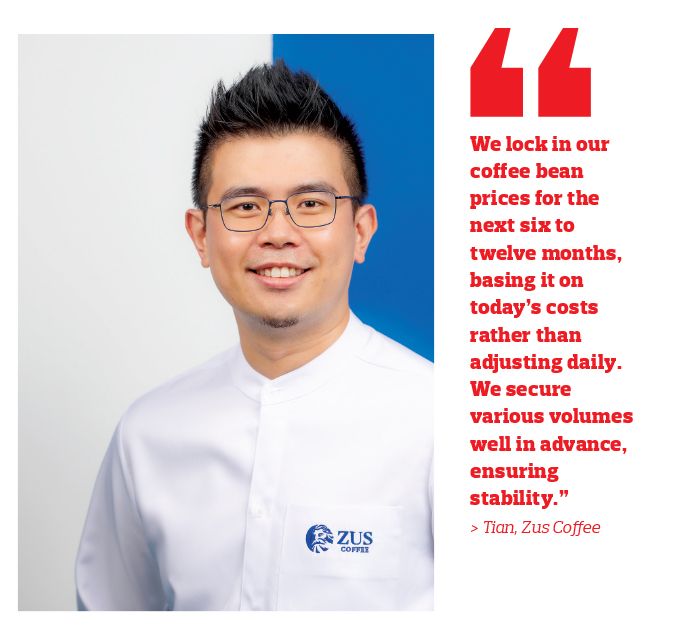
This article first appeared in Wealth, The Edge Malaysia Weekly on February 24, 2025 - March 2, 2025
Coffee bean prices recently reached an all-time high, but coffee enthusiasts can take comfort in the fact that many coffee chains are working hard to prevent menu price hikes in a bid to maintain market share amid stiff competition.
It remains uncertain how long coffee chains can hold prices steady, as coffee bean costs are projected to rise further this year because of climate change, according to industry players.
For example, Zus Coffee, one of Malaysia’s largest homegrown chains, recently raised most of its menu prices by 30 sen — its first price hike since its launch in 2019.
The company cited the increase in costs of raw materials as a big factor, which is in line with the projected spikes in the Coffee C Futures index, a global benchmark on Arabica coffee beans used to observe and track raw commodity costs as well as trends on coffee beans.
As at Feb 13, the Coffee C Futures index active month contract (March) hit 425.1 points, up 35% year to date.
From Jan 1, 2024, to Jan 1, 2025, the index rose about 100%, says Syarikat Kopi Kok managing director Kok Jit Weng. “We anticipate that the Coffee C Futures index will increase further by 15% to 30%.”
Syarikat Kopi Kok is a business-to-business (B2B) coffee company focused on Arabica and Robusta coffee beans sourced from Latin America and Indonesia. Its clientele includes Ben’s Independent Grocer and other smaller coffee businesses.
Despite the uphill battle with increasing costs, Kok sells his coffee beans at RM88 per kg at a minimum order quantity, up 25.71% from RM70 six years ago, or a compound annual growth rate (CAGR) of 3.89%.
Kok explains that Syarikat Kopi Kok’s coffee bags are priced at a level considered average in the market, ensuring the company remains competitive in a fiercely competitive industry.
“When market prices are revised, B2B clients’ margins shrink. Businesses will try to absorb these costs and cut operating expenses before passing increases to their customers,” he says.
Meanwhile, in the Vietnamese coffee market, although exports do not follow the Coffee C Future index, Kee Nguyen co-founder and director Radius Khor points out that the price of local coffee beans has always been rising over the long term.
Founded in 2019, Kee Nguyen is a coffee chain that specialises in Vietnamese coffee and has more than 50 outlets locally, according to a news report in 2023.
Khor says the source prices of Robusta and Arabica coffee beans from Vietnam have consistently increased, yet the company has raised prices only twice since 2019, much like Syarikat Kopi Kok.
Kee Nguyen’s bestselling drink is priced at RM7 today versus RM4 in 2019, a 75% increase and a CAGR of 9.78%.
Echoing Kok, Khor notes that intense competition in the coffee market has played a key role in pricing decisions, with price hikes typically delayed until it is difficult to remain competitive while retaining some profitability.
He adds that fierce competition drove Kee Nguyen to set a price range that balances competitiveness with customer retention, ensuring accessibility while capturing market share.
“When we began, we wanted to sell coffee that offered value for money, but this would mean lower margins for the business. As the business evolved, however, we assessed our competitors and adjusted our prices to fall within a competitive range,” he says.
It is reported that the average net profit margin of industry players is 5%. For instance, Zuspresso (M) Sdn Bhd, the company behind Zus Coffee, recorded a profit after tax margin of 4.97% in its financial year 2023 (FY2023), according to a CTOS report.
Its revenue in FY2023, however, has grown substantially to RM204.12 million, up 134.8% year on year from RM86.92 million. Its FY2023 profit margin also improved from 2.65% and 4.41% in FY2021 and FY2022 respectively.
It will only keep rising
The price hikes in the global coffee market are driven by a mismatch between demand and limited supply, as production has been facing challenges in recent times.
The worsening effects of climate change are seen as a primary driver, if not the leading cause, of the supply shortage and rapid rise in coffee bean prices. Unpredictable weather patterns have led to decreased yields, driving up prices amid growing demand for coffee.
Zus Coffee group chief operating officer Venon Tian says: “This will disrupt the entire global supply chain. People might divert to other regions and it’s going to affect other regions as well. So, the prices of coffee beans from these new areas might increase. It’s a ripple effect.”
Khor notes that this trend is also evident in Vietnam, where worsening climate conditions have prompted some farmers to switch to other crops, such as durians, that produce fruit year-round, resulting in reduced coffee production. In addition, farmers are increasingly recognising the value of their labour and demanding fair compensation.
The weakening ringgit exacerbates the challenges posed by foreign exchange fluctuations, as most coffee beans are sourced from international markets and traded in US dollars.
“For example, the US dollar strengthened against the ringgit from January 2023 to January 2024. I believe this has led to a cost increase of about 10% solely from the exchange rate, not factoring in the rise in raw material prices. This is inevitable and likely to continue,” says Kok.
Arabica, the only type of coffee bean that Zus Coffee uses, is sourced from countries such as Brazil, Ethiopia, the Philippines, Indonesia and Colombia, which are international markets. As leading coffee producers, these countries are crucial to the supply chain, and Zuspresso is hesitant to switch sources to avoid compromising the quality of its coffee.
As a result, Tian explains, Zus Coffee has taken proactive measures by ordering coffee beans months in advance — hence securing prices — to mitigate the impact of rising forex rates.
He says: “We lock in our coffee bean prices for the next six to 12 months, basing it on today’s costs rather than adjusting daily. We secure various volumes well in advance, ensuring stability.”
Even in the Vietnamese market, Khor notes that the ringgit has weakened against the Vietnamese dong over the longer term. He observed this shift recently, whereas in the early days of Kee Nguyen, the ringgit remained stable alongside the dong.
“Every time the Malaysian currency increases, we immediately place an order. We want to capitalise on the periods in which the currency is strong to get a bit of margin,” says Khor.
Working around rising bean prices
In addition to increased coffee bean prices, factors such as targeted petrol subsidies — which will raise the cost of transportation, logistics and ancillary items such as packaging — will affect the price of a cup of coffee.
Kok says other coffee processing procedures such as wastage yields also affect the price of coffee.
“Every time we roast the coffee beans, we lose moisture. For every kilogramme that we buy, 16% to 20% disappears in the form of moisture. So, this also contributes to the costs,” says Kok.
Therefore, extensive internal restructuring and operational optimisation are carried out to offset rising coffee bean prices and manage costs more effectively.
Zus Coffee, as a bigger coffee chain, keeps its margins stable by right-sizing the coffee bags for transportation to reduce wasted space, thus packing more beans in one go and saving on the cost of making extra rounds.
“It’s simply about how to do things much more efficiently. Once you do things as such, you’ll be able to transfer savings across the board,” says Tian.
Zus Coffee has also diversified by introducing fast moving consumer goods (FMCG) such as instant coffee sachets and ready-to-drink cans under its brand, providing an affordable alternative for Zus Coffee customers with lower budgets.
Operating on the B2B side, Kok observes that large companies, despite facing margin pressures from price hikes, have the capacity to trim operating expenses before passing the cost on to consumers. However, this puts smaller businesses at a greater disadvantage.
“Smaller businesses might struggle to manage rising raw material costs and eventually close shop. This means that wholesale customers are likely to end up working with just a few larger suppliers to keep their costs under control,” says Kok.
Locally produced coffee for sustainability
Coffee industry players predict that if prices rise too high, Malaysia may be forced to develop its own coffee farming industry. “A sustained increase in coffee bean prices could encourage local producers to invest more in coffee farming, potentially reducing reliance on imports. This is not widely practised at the moment, though,” says Tian.
Meanwhile, Khor notes that local coffee production is already on the rise, driven by the growing number of new coffee chains and consistent demand from local consumers.
Malaysia produces a type of coffee bean called Liberica, its flavour is distinct, with a slightly fruity taste compared to the more popular and sought-after Arabica and Robusta grades.
“Local produce would save companies much more money, but I don’t know whether the good coffee beans will be exported and Malaysians will be left with the low-quality beans,” says Khor.
The success of Malaysia’s local coffee farming industry will depend on its ability to meet global quality standards. Major coffee producers such as Brazil and Indonesia have already established themselves as irreplaceable markets, thanks to favourable environmental conditions and arable land, as well as the reputation of their coffee beans.
Save by subscribing to us for your print and/or digital copy.
P/S: The Edge is also available on Apple's App Store and Android's Google Play.
- Sapura Resources sues ex-MD Datuk Shahriman and others for over RM3 mil in damages
- Anwar receives courtesy visit from tech giant Oracle, discusses AI and digital innovation
- Singapore man accused of Nvidia chip fraud wields global connections
- Stocks extend drop, dollar falls on tariff woes
- Trump’s manufacturing dreams clash with business owners’ reality



